Marks which are deemed to be "misleading" or having a "negative influence" can be cancelled. How can you prevent it?
Are your trademarks potentially misleading? Or can they be deemed as having a negative influence on society? Both of these are grounds for cancellation in China. Rouse's Amanda Yang and Jasmine Lv look at examination criteria and trends, provide relevant examples and highlight strategies for trademark owners to adopt.
In recent years, trademark applicants in China have encountered an increasing number of unexpected rejections, with reasons including the mark being deemed as "misleading" or having a "negative influence". The relevant articles in the legislation are abstract and difficult to understand by brand owners or IP practitioners; yet, using trademarks in violation of these articles carries a high risk of punishment by the local authorities. To better understand this landscape, Rouse has conducted research into the examination criteria applying to the relevant articles.
Recent trends
Article 10 of the China Trademark Law reads as follows:
The following signs shall not be used as trademarks:...
7. Those that may easily mislead the public concerning characteristics such as the quality of the goods or their place of production; and
8. Those detrimental to socialist morals or customs, or having other unhealthy/negative influences.
Trademarks violating these two provisions are prohibited not only from being registered, but also from being used. China's National Intellectual Property Administration (CNIPA) applies stringent examination standards to trademarks that may potentially infringe these provisions. Although trademark applicants have the right to file for review with the Trademark Review and Adjudication Board (TRAB), the likelihood of success in such reviews is minimal.
According to our research, refusal notices are not publicly available, while refusal appeal decisions issued by the TRAB are open to the public. However, we obtained the decisions on a third-party commercial database, Mozlen. The graphs below illustrate the number of trademark refusal review cases (closed cases) between 2018 and 2023, as well as the ratio of appeals successfully overcoming rejections under Article 10(1)(7 and 8) of the Trademark Law.
Appeals of refusals due to misleading issues under Article 10(1)(7)
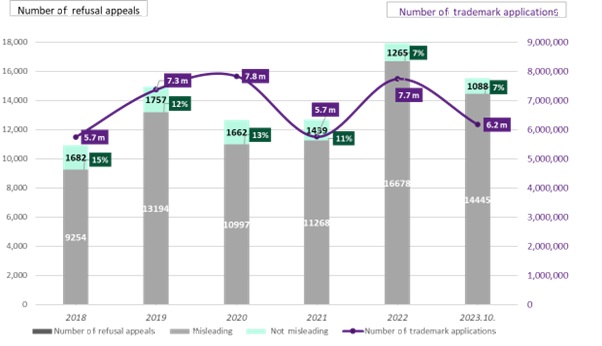
Source: Rouse
The speed of examination for a new application is around four to six months from the filing date, and around six to eight months for the examination of a refusal appeal. Therefore, it takes around 10 to 14 months for an application to go through substantive examination and a subsequent refusal appeal.
In the above graph, the columns represent the number of refusal appeal decisions based on a trademark being deemed misleading, while the purpose line indicates the total number of new applications filed in the previous year. This means that, in a year with a high total number of new applications, the total number of refusal appeals is correspondingly high. The graph illustrates that the risk of applications being rejected has increased over time. The chance of overturning the refusal of a trademark that was deemed misleading has dropped from 15% in 2018 to 7% in the past two years.
Appeals of refusals due to negative effect under Article 10(1)(8)
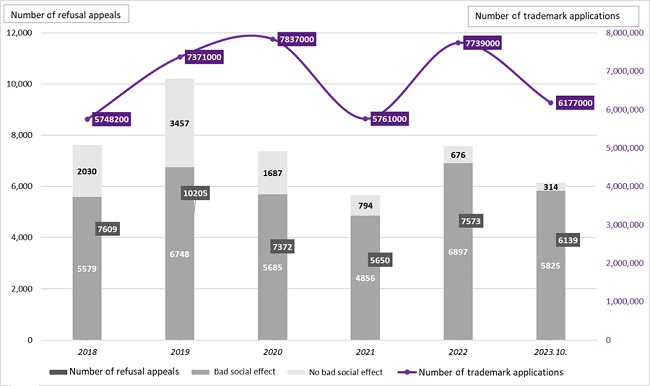
Source: Rouse
The columns in the above graph represent the number of refusal appeal decisions due to the mark being deemed to have a negative social influence. Before the amendment to the Trademark Law in December 2019, no provision clearly tackled bad-faith filings. Therefore, the China Trademark Office (CTMO) and the TRAB tended to use Article 10(1)(8) and find that bad-faith filings had a negative influence on society. This is why the total number of refusal appeal decisions in 2019 is very high, as seen in the chart. The data also shows that the chance of overturning a refusal based on Article 10(1)(8) dropped from 27% in 2018 to around 5% in 2023. It is thus apparent that the probability of overcoming the grounds for rejection under Article 10(1)(8) at the TRAB stage is low.
Examination standards for, and examples of, "misleading" trademarks
For the benefit of foreign applicants who lack familiarity with Chinese trademark examination and practice, we have looked more closely into how to handle rejections and the risks associated with trademark use.
The 2021 Trademark Examination and Adjudication Guidelines issued by the CNIPA state that Article 10(1)(7) of the Trademark Law may be violated if a trademark is deemed "misleading". This refers to a trademark misrepresenting the quality or origin of the designated goods through false claims, exaggerations beyond reality or contradictions with factual information, thus potentially misleading consumers as to the quality or origin of the goods (eg, using terms such as 'healthy' and 'longevity' for tobacco products).
The assessment of whether a specific trademark is "misleading" necessitates an analysis of the designated goods and services, alongside their respective characteristics. However, if the likelihood that consumers will be misled as to the quality or origin of the goods or services is low, then the corresponding trademark does not fall within the scope of Article 10(1)(7). Trademarks that fall within the scope of this provision include signs that easily lead the public to be misled as to:
- the quality, excellence, functionality, purpose, ingredients, content, weight, quantity, price, craftsmanship, technology and other aspects of the goods or services; and/or
- the origin or source of the goods or services.
The table below provides examples of trademarks that were found to violate Article 10(1)(7).
Trademarks deemed as "misleading" by CTMO – rejection upheld by TRAB/court
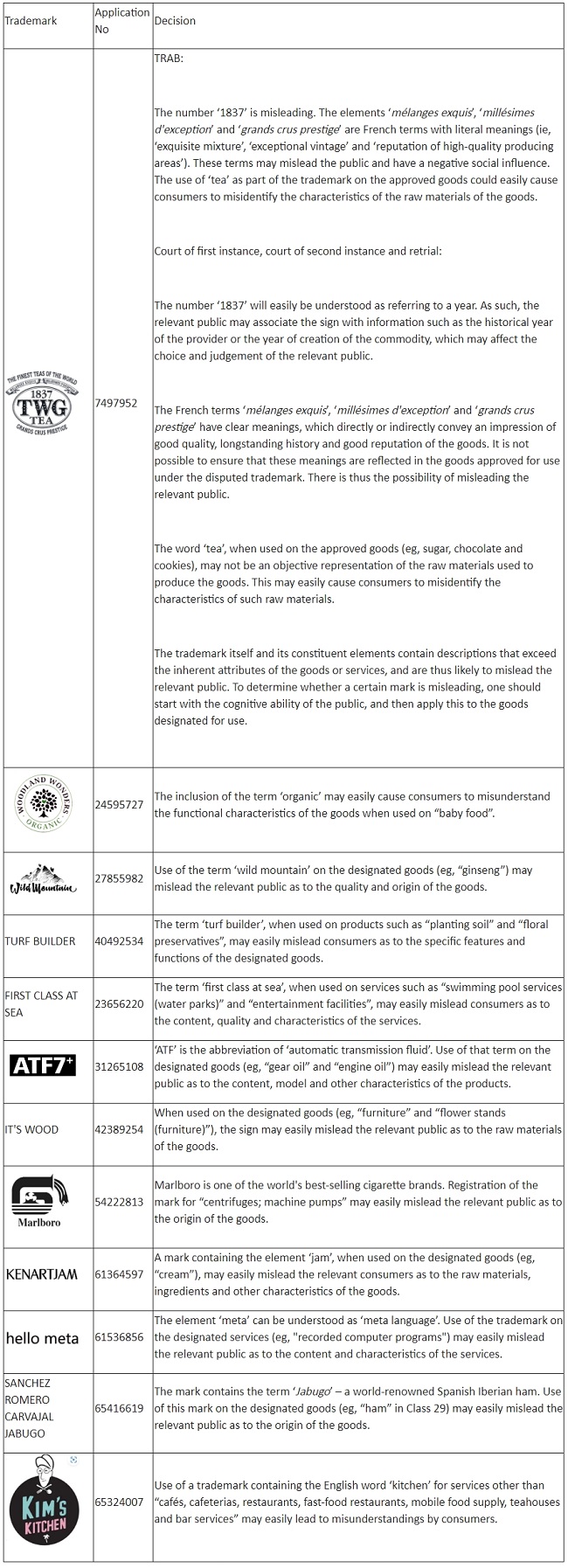
Trademarks deemed as "misleading" by CTMO – rejection overruled by TRAB/court
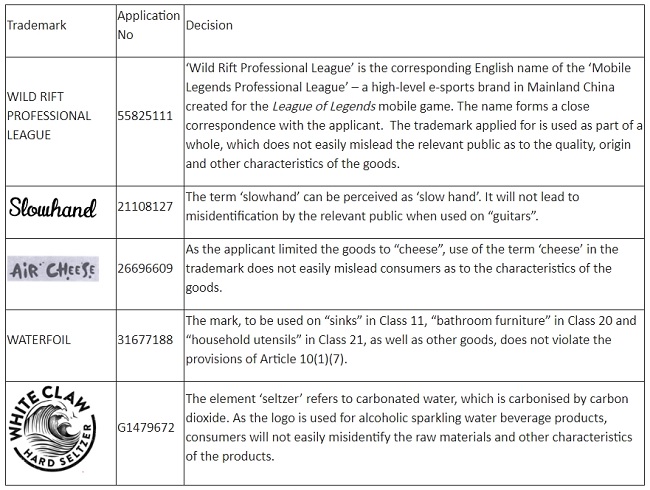
Examination standards for, and examples of, trademarks with a "negative influence"
In the 2021 Trademark Examination and Adjudication Guidelines of the CNIPA, the phrase "socialist moral standards" in Article 10(1)(8) of the Trademark Law was explained as encompassing "the principles, norms and prevailing customs and habits of public life and behaviour within our nation during a specific period". The term "other negative influence" includes not only situations that undermine socialist values, but also signs containing text, graphics or other elements with derogatory meanings or perceived negative impacts on China's political, economic, cultural, religious and ethnic interests, as well as on public order.
When determining whether a trademark could be deemed detrimental to socialist moral standards or as having some "other negative influence", factors such as the political background, social context, historical circumstances, cultural traditions, ethnic customs and religious policies should be taken into account. In general, the factual status at the time of examination will prevail when judging whether a sign or its constituent elements have "other negative effects".
Specific circumstances under Article 10(1)(8) encompass, but are not limited to, trademarks that:
- are deemed harmful to socialist moral standards;
- are deemed to produce a negative political influence; and/or
- may be deemed to be detrimental and as having a negative influence on China's economy, culture, ethnicity, religion and society, thereby causing harm to the public interest and public order.
The table below provides examples of trademarks that were found to violate Article 10(1)(8).
Trademarks deemed to have "negative influence" by CTMO – rejection upheld by TRAB/court
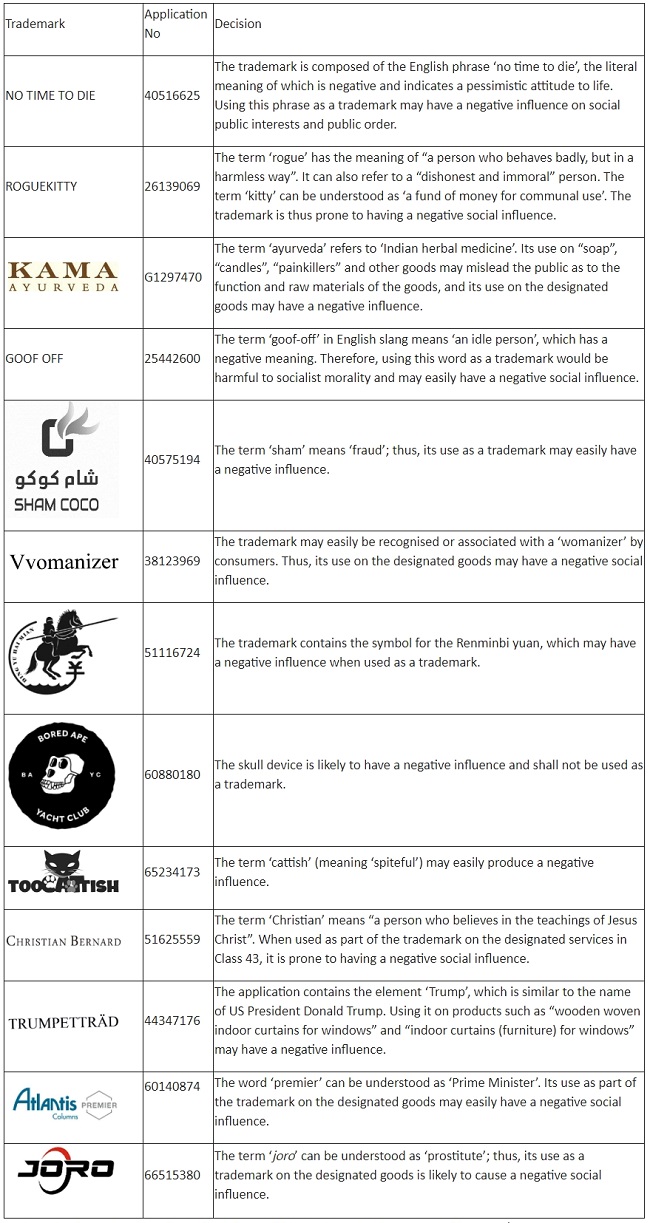
Trademarks deemed to have "negative influence" by CTMO – rejection overruled by TRAB/court
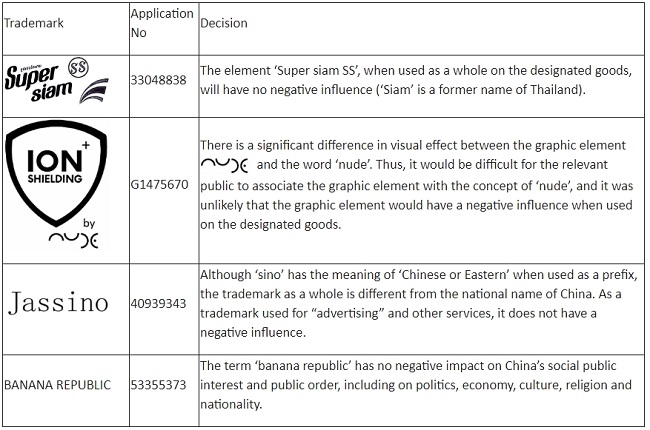
Strategic advice: how to reduce the risk of violating Articles 10(1)(7) and (8)
As marks that are deemed to be "misleading" or have a "negative influence" cannot be registered or used, there is a risk when using such marks in the market. Article 52 of the Trademark Law stipulates as follows:
[T]he local administrative department for industry and commerce shall stop such use, order rectification within a specified period, and may circulate a notice on the matter. If the illegal business revenue is over Rmb50,000 (around $6,900), a fine of up to 20% of such revenue may be imposed; if there is no illegal business revenue or a business revenue of less than Rmb50,000 (around $6,900), a fine of up to Rmb10,000 (around $13,800) may be imposed.
In light of the difficulties of overcoming rejections on the ground that the marks are "misleading" or have a "negative influence" (as well as due to potential risks during use), applicants should consider the following steps:
- Before filing a trademark application, it is recommended to conduct searches on the registrability of a mark, and to evaluate the risk of the mark being deemed as "misleading" or having a "negative influence". A pre-application trademark registrability assessment can assist applicants in adjusting their application strategy, thereby enhancing the chances of successfully obtaining a trademark registration and avoiding the need to redesign the trademark. The rejection of a trademark application on the ground that it is "misleading" or has a "negative influence" may result in a delay in registering such trademark and impede the applicant's business plan.
- Applicants may remove the "misleading" or
"negative" parts from the trademark if such parts are
descriptive or unimportant. Below are some tips to apply when a
trademark is found to be "misleading":
- For trademark applications covering food and medicine, the CNIPA applies stricter scrutiny concerning "misleading" elements. As it is even harder to overcome rejection in these circumstances, it is advisable to remove the misleading parts.
- Applicants should carefully select the designated goods or services to avoid an overly broad scope that could lead to comparisons with unrelated goods or services. For example, when filing a mark containing a word that describes the ingredient of a product, it is advisable to file only for goods specifically containing that ingredient (eg, "cheese" for the mark AIR CHEESE) or limit the goods (eg, the mark WESTIN WHITE TEA ALOE for "soap containing white tea and aloe vera extract ingredients"). If the goods limitation is not allowed (as the CTMO tends to accept the standard wording of the Nice Classification) and the application is rejected, the applicant can then apply for review and consider abandoning some unrelated goods or services. Applicants can also provide evidence demonstrating the relationship between the applied-for mark and the approved goods or services.
- If a trademark application is rejected under Article 10(1)(7) or (8), applicants should be cautious when applying for a review. If the review is unsuccessful, the decision will be published and open to the public. If an applicant already owns prior registrations and the new application is just a back-up, then a review against the rejection is not recommended, as this may affect existing registrations.
- If a mark containing an element deemed to be "misleading" or "negative" has been put to use, that mark should not be used after the application has been refused. If it is descriptive of the goods, then using it in a non-trademark way (ie, not attaching the symbols TM or ®) may reduce challenges from the Chinese Market Supervision and Administration. We have found some penalty decisions based on violations of Articles 10(1)(7) and (8) in our search of third-party databases, with dozens of cases involving violations of Article 10(1)(7) and around 100 cases involving violations of Article 10(1)(8) in the past five years.
Co-authored by Jasmine Lv
Originally Published by World Trademark Review in January 2024
The content of this article is intended to provide a general guide to the subject matter. Specialist advice should be sought about your specific circumstances.


